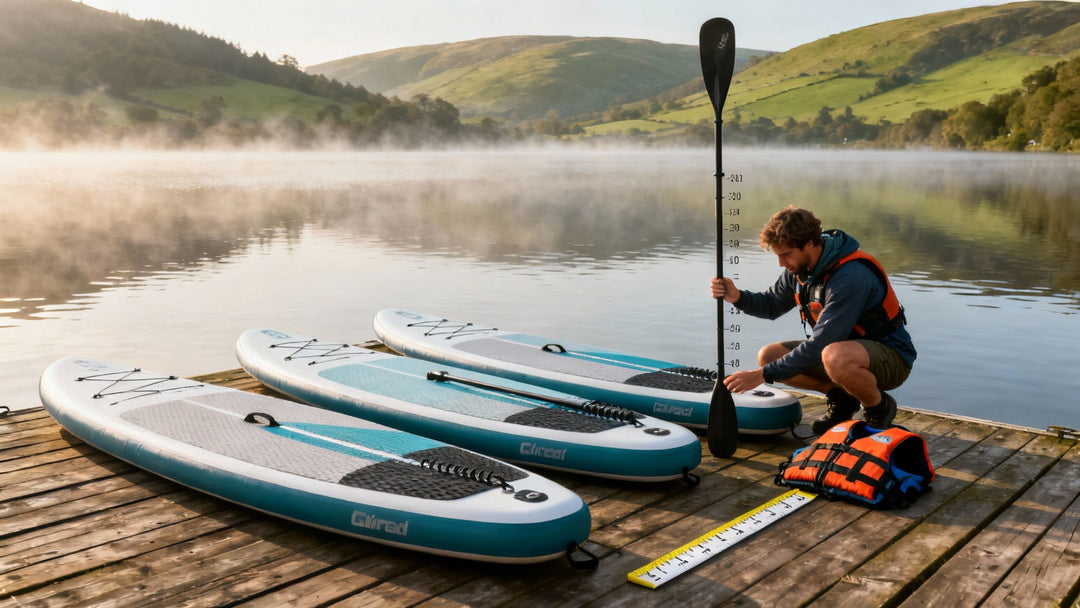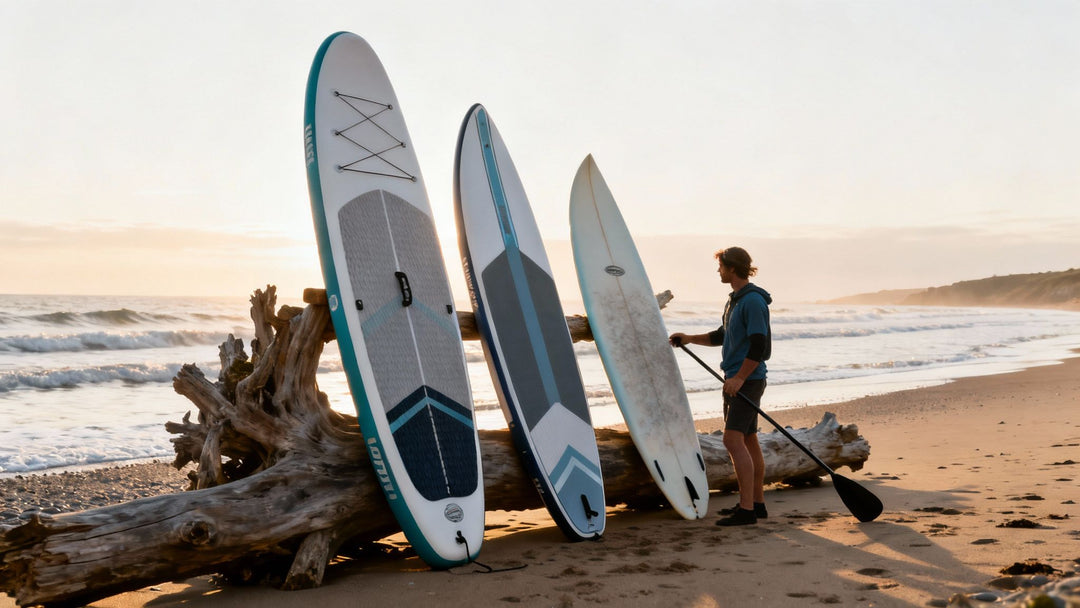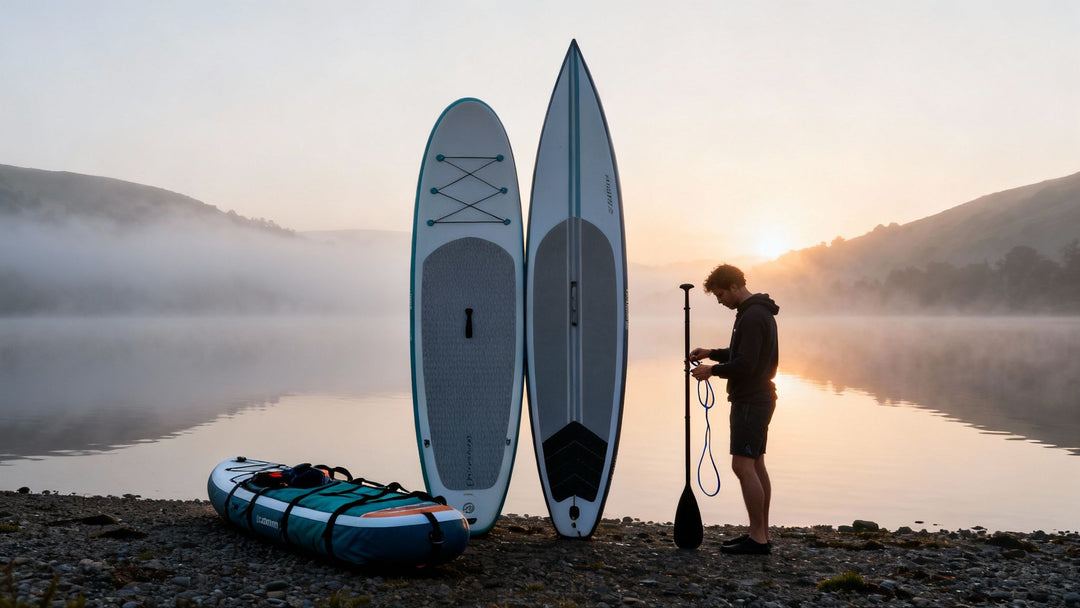How to choose a paddle board: a practical UK guide to sizing and gear
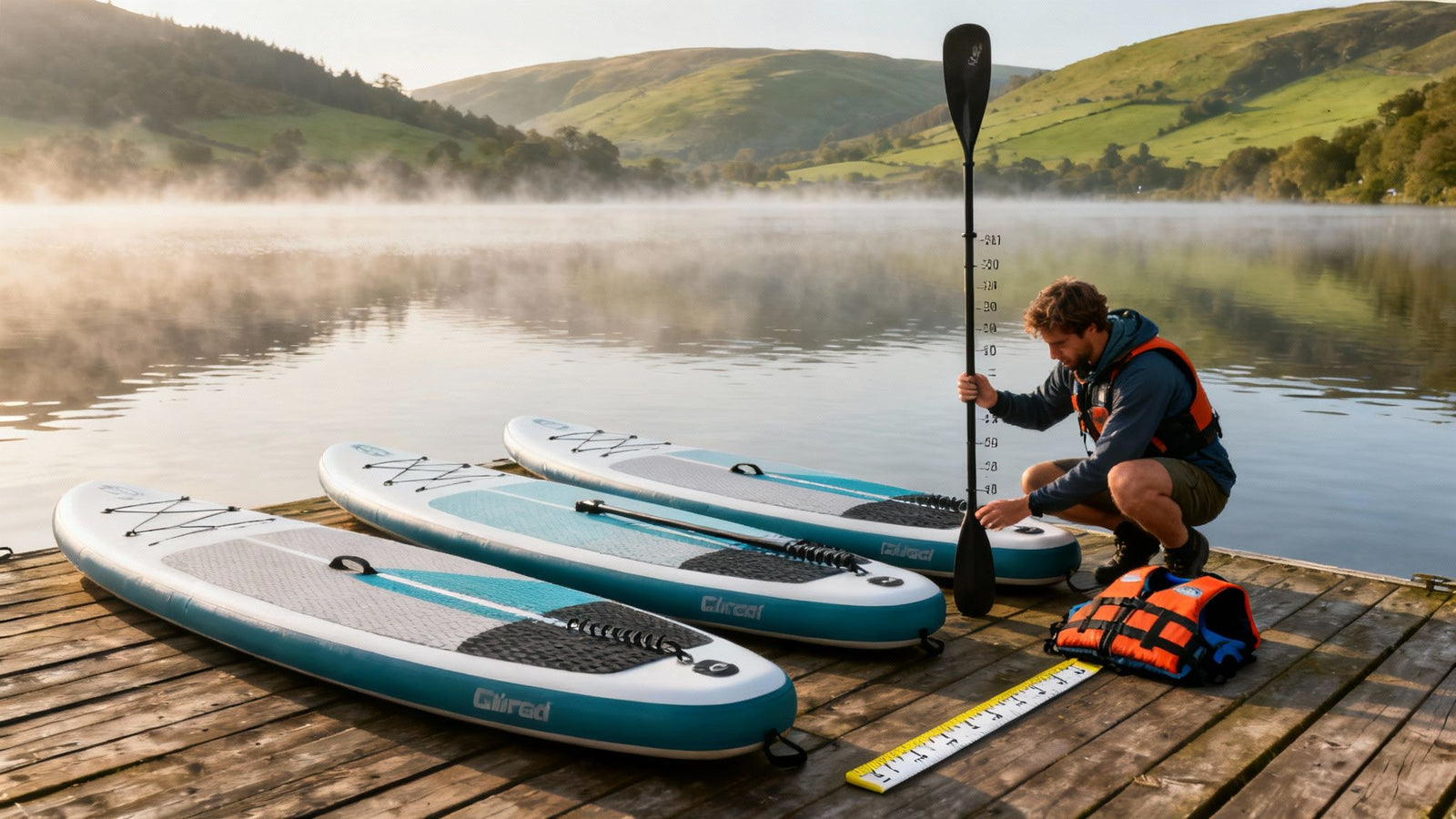
The first question to ask yourself when choosing a paddle board is simple: what kind of adventure are you actually going for?
Forget the technical specs for a moment and picture yourself out on the water. Your decision should start there. When you match the board's design to how you plan to use it, everything else falls into place, whether you’re dreaming of calm lakes, coastal waves, or long-distance journeys. For example, if your goal is paddling along the Jurassic Coast, your board choice will be very different than if you're planning gentle Sunday paddles on the River Wye.
Matching Your Board to Your Adventure
Before we get bogged down in dimensions and materials, let's look at the main types of stand-up paddle boards you’ll come across. Each is built for a specific purpose, and picking the right category from the get-go is the most important step in finding a board you'll genuinely love.
Think about where you'll be paddling here in the UK. Is it a gentle river, a choppy coastal bay, or a glassy local loch? Your answer will almost certainly point you towards one of these three core designs.
The All-Rounder: Your Versatile Go-To
For most people just starting out, an all-round board is the perfect first step. These boards are the jacks-of-all-trades, designed for great stability and ease of use in all sorts of conditions. They’re typically wider with a rounded nose, which makes them feel super secure and forgiving underfoot—perfect for family fun, gentle cruises, and even a bit of SUP yoga.
A classic example is an inflatable like the Loco Amigo Air, which is a firm favourite for its do-it-all nature. It’s stable enough for a complete beginner to find their balance on a calm lake, yet it’s still versatile enough to handle small waves if you fancy a trip down to the Cornish coast. It's no surprise they're so popular; they are the gateway for most new paddlers.
The Touring Board: Built for Distance
If you’re dreaming of exploring further and covering more ground (or water!), then a touring board is your best bet. These boards are longer and narrower, with a pointed nose designed to slice through the water efficiently. That shape helps the board track straight and glide much further with every single paddle stroke.
Imagine paddling the length of Windermere or exploring the Norfolk Broads. A touring board like our Loco Motion Air makes those longer journeys feel less like hard work and more like an adventure. They can feel a bit less stable at first compared to an all-rounder, but their speed and efficiency are a huge payoff for anyone serious about distance paddling.
Key Takeaway: Don't just buy the most popular board on the market. Buy the board that fits the kind of paddling you actually want to do. An all-rounder is fantastic for its versatility, but if you know deep down you want to cover miles, a touring board will serve you so much better in the long run.
The Surf SUP: Designed for Waves
For the thrill-seekers drawn to the coast, a surf SUP is a highly specialised tool built specifically for catching waves. These boards are much shorter, far more manoeuvrable, and have a shape that’s heavily inspired by traditional surfboards. This design is what allows you to turn sharply and carve on the face of a wave.
A performance-focused board like the Loco El Diablo is crafted just for this. It’s definitely not the board you’d pick for a leisurely paddle down the river—its twitchiness on flat water would just be frustrating. But in its element, the surf, it’s absolutely brilliant.
Across all board types in the UK, weight capacity is a critical factor. In fact, research shows that around 60% of new buyers go for all-round boards because they offer fantastic stability for paddlers between 70 kg and 100 kg, making them reliable in our often unpredictable UK weather. You can dig deeper into these trends in the Europe paddle sports equipment market report.
Getting Board Size and Volume Right
Alright, so you've figured out what type of board you want. Fantastic. Now for the next big question: what size do you need? This is where a lot of people get bogged down in numbers, but honestly, it’s simpler than it looks. The length, width, and volume of a board all work together to define how it’s going to feel when you’re out on the water.
Think of it as a balance between stability and performance. Wider boards are your best friend when you're starting out. They give you a solid, steady platform that builds confidence, making them perfect for beginners, SUP yoga, or just having a relaxed paddle. A board like the Loco Discovery, for example, feels super planted, letting you focus on your paddling without worrying about taking an unexpected dip.
On the flip side, longer and narrower boards are all about speed and glide. They cut through the water more efficiently and track in a straight line, meaning you get more distance from every single paddle stroke. If you’re planning on touring or covering ground on rivers and coastlines, this is the design you’ll want.
Understanding Board Volume
More than just its length and width, a board's volume is probably the most crucial number to get right. Measured in litres, volume tells you how much weight the board can float. If you choose a board with too little volume for your weight, it’ll sit low in the water, feel wobbly as anything, and be a real struggle to paddle.
The aim is to find a board with enough volume to comfortably support you and any gear you’re bringing along. For instance, if you plan to take a dry bag with lunch and a camera, or even have your dog on board, you must account for that extra weight. This keeps you riding on top of the water, not ploughing through it, which is key for stability and a smooth glide.
As a simple starting point for beginners, look for a board with a volume in litres that’s at least double your weight in kilograms. So, if you weigh 80kg, you should be looking for a board with 160L of volume or more.
To give you an idea of what most paddlers in the UK are using, have a look at this chart.
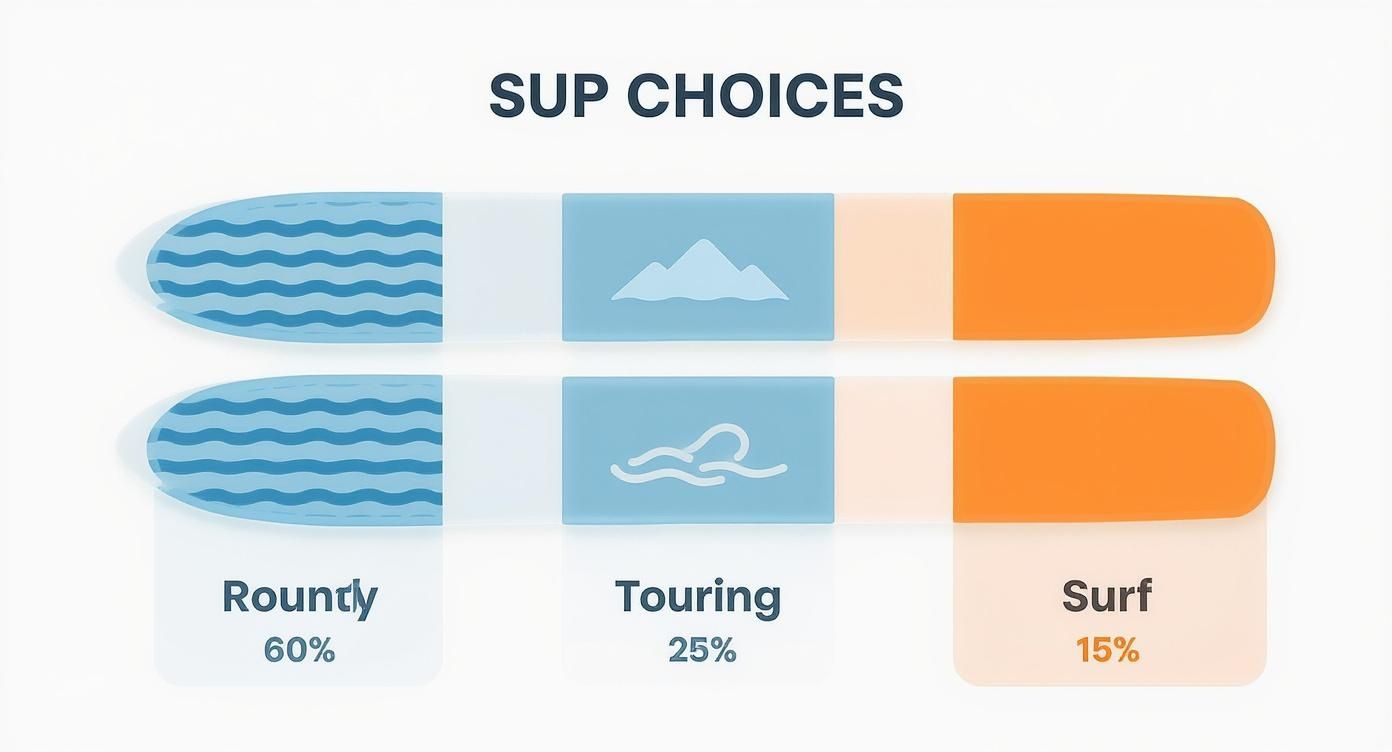
It’s pretty clear that all-round boards are the go-to choice for most people. Their blend of stability and versatility makes them a winner for new and casual paddlers.
A Practical Sizing Guide
To help you narrow down the options, we’ve created a handy table matching your weight to the ideal board volume and width. This is a great starting point for finding your perfect match.
Paddle Board Sizing Guide by Paddler Weight
Use this table to match your body weight to the ideal paddle board volume and dimensions for optimal stability and performance.
| Paddler Weight (kg) | Recommended Board Volume (Litres) | Recommended Board Width (Inches) | Best For |
|---|---|---|---|
| Under 70 kg | 150 - 200 L | 30" - 32" | Lighter riders seeking stability & control |
| 70 - 90 kg | 200 - 270 L | 32" - 34" | Average-weight beginners and intermediates |
| 90 - 110 kg | 270 - 320 L | 33" - 35" | Heavier riders needing maximum stability |
| Over 110 kg | 320+ L | 34" - 36" | Maximum buoyancy for heavier paddlers |
This should give you a solid foundation, but if you want to dive deeper into the nitty-gritty, check out our complete guide on what size paddle board you need. It’s packed with extra details to help you make a choice you’ll be happy with for years to come.
Inflatable vs Solid: Which Board Fits Your Lifestyle?
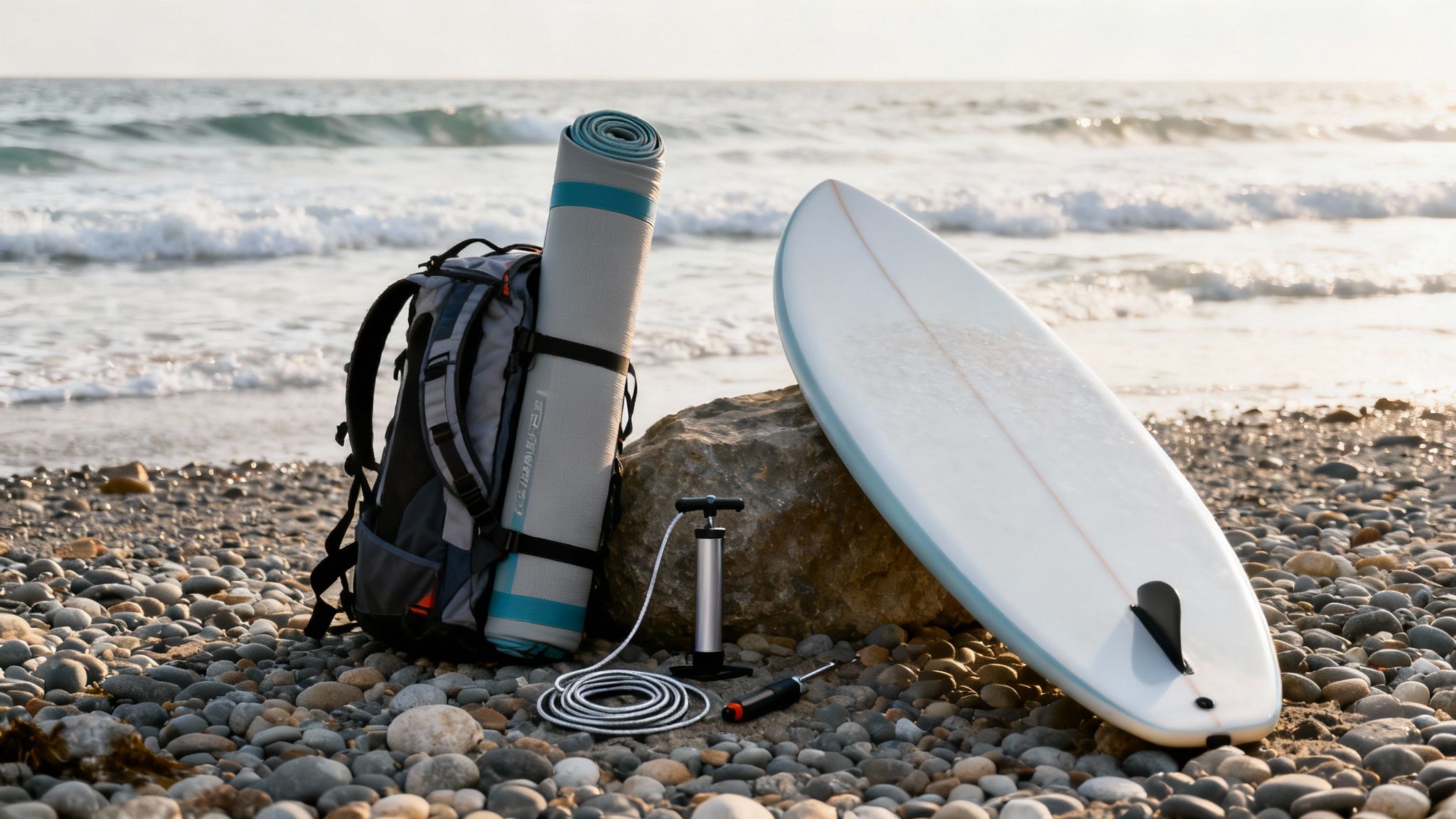
Right, you’ve got a handle on the different board shapes and sizes. Now for the big one: should you go for an inflatable or a solid board? This is probably the most important decision you'll make, as it dictates everything from storage and transport to how the board actually feels under your feet.
There's no single "best" answer here. It all comes down to your personal paddling style and, frankly, your lifestyle.
The Case for Inflatable SUPs
Inflatable Stand-Up Paddleboards (or iSUPs) have absolutely taken over the market, and for one simple reason: convenience. It's a game-changer. An iSUP deflates, rolls up, and fits neatly into a large backpack. You can chuck it in the boot of a Mini or stash it in a cupboard at home. No roof rack needed, no giant board hogging your garage.
Think about it. You could pack up your Loco Motion Air touring board, sling it over your shoulder, and jump on a train to the Lake District for the weekend. That's the kind of freedom an inflatable gives you. And don't mistake "inflatable" for "flimsy". Modern iSUPs like those in the Loco inflatable range are built like tanks with military-grade PVC materials, making them surprisingly tough. They'll shrug off knocks against rocks and pontoons that would leave a nasty ding in a solid board.
It's no surprise that iSUPs dominate the UK scene, holding about 55% of the market. This is driven by that incredible ease of transport and a more forgiving price tag. A decent mid-range model will typically set you back between £600 and £800, making them a fantastic entry point for new paddlers.
The Power of Solid Boards
Inflatables might win the convenience battle, but when it comes to pure on-water performance, solid boards are in a different league. Often called hard boards, they're typically built with materials like epoxy, fibreglass, and carbon fibre wrapped around a foam core. This construction delivers one crucial thing: rigidity.
A solid board doesn't flex. At all. This creates a direct connection to the water, meaning every ounce of effort from your paddle stroke is converted into forward momentum. It just feels more responsive. A practical example is trying to catch a small, fast-moving wave at a spot like Fistral Beach; a solid board will accelerate onto the wave face instantly, whereas an inflatable can feel sluggish in comparison.
This rigidity brings some key advantages to the table:
- Superior Glide: They slice through the water with minimal resistance, making them faster and far more efficient over distance.
- Enhanced Responsiveness: They react instantly to every little shift in your weight, which is non-negotiable for high-performance disciplines like SUP surfing or racing.
- Finer Shapes: The manufacturing process allows for much more complex and refined contours, optimising the board's hydrodynamics for a specific purpose.
If you’re serious about catching waves or want to get into racing, a solid board is the only real choice. Our premium carbon constructions, for instance, are specifically engineered to maximise speed and agility, giving a proper competitive edge. If performance is what you’re chasing, the difference is night and day.
Key Insight: Your choice boils down to a trade-off. Do you prioritise the grab-and-go convenience of an inflatable, or the uncompromising performance of a solid board? There's no wrong answer, only what's right for your paddling life.
For those who lean towards performance and have the space for a 10-foot-plus board, the on-water experience is second to none. If you're intrigued by the advantages a rigid construction offers, our detailed breakdown on why you might choose a hard board over an inflatable is a must-read. It delves deeper into the performance gains that can truly elevate your paddling.
Understanding How Hull Shape and Fins Affect Your Ride
So, you’ve nailed down the right size and construction for your new board. Fantastic. But now we get into the nitty-gritty details that really define how a board feels under your feet: the hull shape and the fins.
Think of these as the board's personality. They control how it glides, how it turns, and how it handles everything from glassy lakes to choppy seas. Getting this part right is the difference between a good day on the water and a truly great one.
The hull is simply the bottom of your board. Its shape dictates whether you’ll be skimming effortlessly on top of the water or cutting through it like a knife. This one design choice makes a massive difference.
Planing vs. Displacement Hulls
When you start browsing for boards, you'll quickly see two main designs crop up.
The most common one, especially for all-rounders and surf SUPs, is the planing hull. It’s flat and wide, designed to sit on top of the water’s surface, a bit like how a speedboat gets up on the plane. This gives you brilliant stability and makes the board super easy to turn, which is exactly what you want for leisurely paddles, catching waves, or even a bit of SUP yoga. Our Loco Amigo Air is a perfect example of a board with a planing hull.
On the other hand, you have the displacement hull. You'll recognise it instantly by its sharp, pointed nose that looks more like a kayak or canoe. This V-shape is built to slice through the water, not ride over it. The result? Far less drag, making the board faster and much more efficient when you’re covering distance. It’s the go-to design for touring and race boards like the Loco Motion Air, where paddling in a straight line and getting the most out of every stroke is the name of the game.
Picture This: You're paddling across a lake with a bit of a breeze picking up. A board with a planing hull will feel solid and stable, but the wind might push it around a bit. A displacement hull, however, will cut straight through the chop, hold its line beautifully, and feel noticeably faster, meaning less effort for you.
Getting to Grips with Fins
Fins are your board's steering and stabilising system. Simple as that. Without them, the tail of your board would just fishtail uncontrollably, and you wouldn't get anywhere fast. The great thing is, you can often tweak the fin setup to match the conditions.
Here are the most common configurations you’ll come across:
-
Single Fin: A classic setup with one large fin in the centre. This gives you fantastic tracking (the ability to paddle straight) with very little drag. It’s the perfect choice for flat-water cruising on lakes and calm rivers where you just want to glide efficiently.
-
Thruster (Three-Fin) Setup: This is probably the most recognisable setup: one larger centre fin flanked by two smaller side fins (often called 'side bites'). It offers a brilliant mix of straight-line stability and real grip and control when you're turning. It’s the standard for all-round boards and a must-have for SUP surfing, where you need to bite into the wave face.
-
2+1 Setup: Think of this as the best of both worlds. It’s a versatile thruster setup where you can choose your configuration. For a practical example, on a calm day you could pop in just the large central fin for a long-distance tour on the Norfolk Broads. Then, for a weekend trip to a surf spot in Wales, you can add the two smaller side fins for extra control and performance in waves. Many of our Loco hard SUPs offer this option, giving you maximum flexibility from a single board.
Choosing Your Paddle and Essential Kit
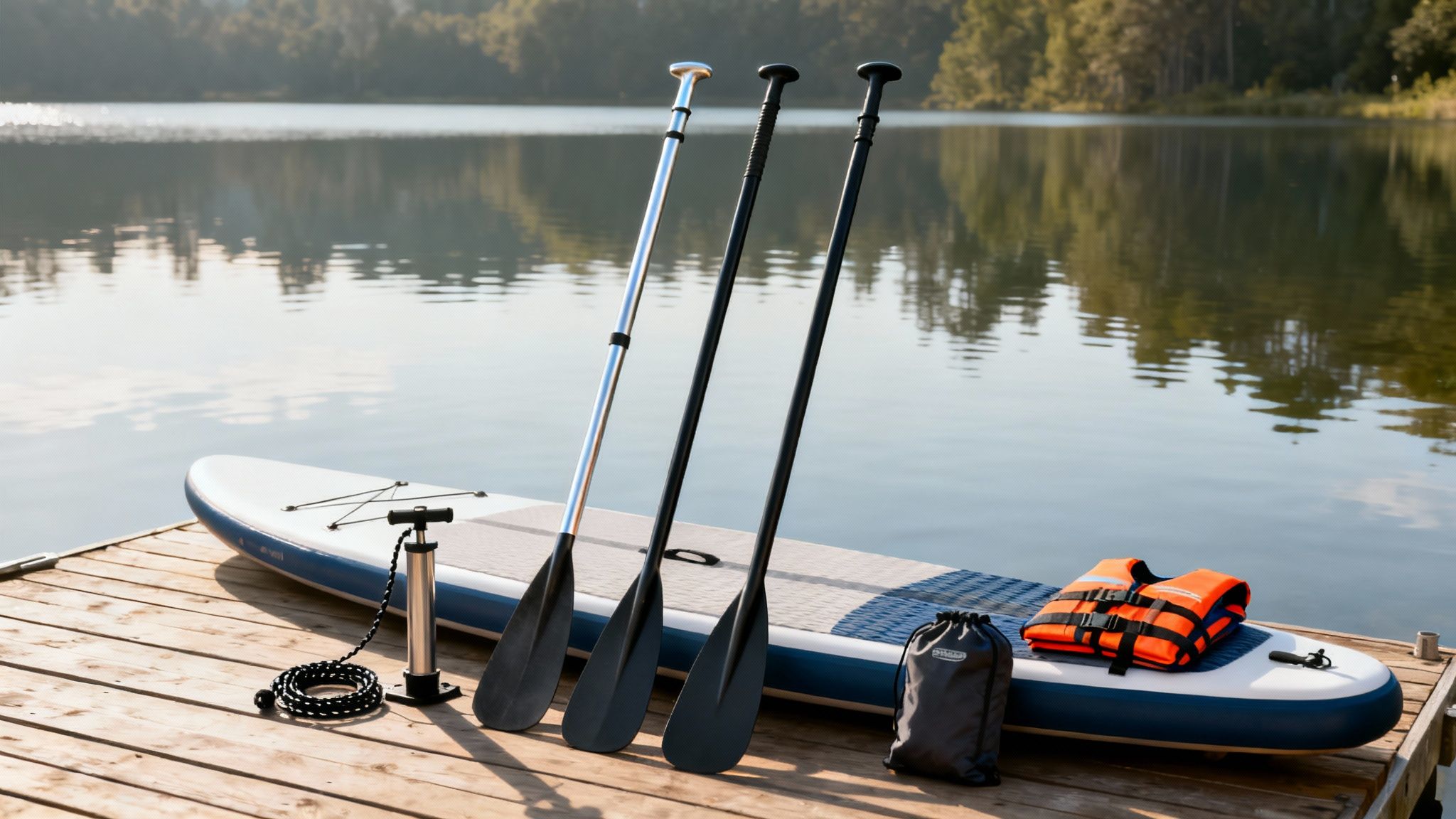
You’ve found the perfect board—fantastic! But that’s only half the battle. Your paddle is the engine that drives your board, and getting it right can make or break a day on the water. The wrong one will leave you feeling frustrated and knackered, while the right one feels like an extension of your own body.
Beyond the paddle, there are a few other bits of kit that are simply non-negotiable for staying safe and having a good time, especially here in the UK.
Most board packages come with a basic aluminium paddle. It’ll get you started, but they’re heavy and unforgivingly stiff, which means your shoulders will be screaming after a short while. Honestly, the single best upgrade you can make to your setup is a lighter, more efficient paddle.
Selecting the Right Paddle
Paddles come in a few different materials, and each offers a trade-off between weight, flex, and of course, price. Knowing what’s what is key to finding your perfect match.
- Aluminium: This is the entry-level option you'll find in most iSUP packages. It's tough as old boots, but it’s also the heaviest material out there. Fine for a quick splash about, but you'll really feel that weight on longer journeys.
- Fibreglass: A brilliant middle-ground. You get a serious weight saving over aluminium without the hefty price tag of full carbon. A fibreglass shaft paired with a nylon blade is a really popular combination for good reason—it just works.
- Carbon Fibre: This is the top-tier choice for anyone serious about performance. Carbon paddles are incredibly light and stiff, which means almost all of your effort goes directly into pushing you forward. A full carbon paddle from the Loco accessory range makes a world of difference; you'll find you can paddle for longer with much less fatigue.
Pro Tip: If you only have the budget for one upgrade after buying your board, make it the paddle. A lighter paddle does more to reduce fatigue and improve your technique than any other piece of gear. Our guide to selecting the perfect SUP paddle has even more detail on this crucial choice.
Must-Have Safety and Practical Gear
Once your board and paddle are sorted, it’s time to think about safety. As you look at building up your kit, you'll see the real value in investing in your own equipment, a principle that holds true across all watersports.
Here’s what should always be on your essential kit list:
- Buoyancy Aid: A personal flotation device (PFD) is a must, especially if the water is choppy or cold. Look for a slimline design that won’t get in the way of your paddling motion.
- Leash: Your leash is literally your lifeline. It keeps you connected to your board if you take a tumble. Crucially, you must use the right type for the conditions. A coiled leash is for flat water, and a straight leash is for surf. If you're on moving water like a river, a quick-release waist belt is absolutely essential for your safety.
- Dry Bag: A small dry bag is a godsend for keeping your phone, car keys, and a few snacks safe and dry while you're out exploring. A 10L bag, for instance, is a perfect size for a day trip.
Common Questions from New Paddlers
Diving into the world of paddle boarding is an amazing feeling, but it’s completely normal to have a few questions floating around before you commit. To help you get that last bit of confidence, we’ve put together answers to the most common queries we get from paddlers ready to buy their first board.
Getting these details sorted helps you make a choice you’ll be happy with for many seasons to come.
How Much Should I Spend on My First Paddle Board?
For a really solid entry-level package here in the UK, you should budget somewhere between £500 and £800. That price point will usually get you a well-made inflatable board, along with a decent paddle, pump, and bag – everything you need to get going with gear that performs well and is built to last.
You'll see super cheap packages out there for under £300, and it's wise to be a bit sceptical. They often cut corners with inferior materials and flimsy construction. The result? A board that flexes like a banana, performs poorly, and probably won't last you very long. Investing that little bit more upfront with a trusted brand like Loco means you're getting better durability, safety, and a far more enjoyable time out on the water.
Do I Need a Licence to Paddle Board in the UK?
Good news – you don't need a licence for paddling on the sea, estuaries, or any tidal water. Happy days! However, if you're planning to explore inland waterways like rivers and canals, many of these are managed by bodies like the Canal & River Trust or the Environment Agency, and they do require a waterway licence.
The simplest way to get yourself covered for most of these managed waterways is to become a member of British Canoeing. The licence is included as part of your membership fee, making it a fantastic all-in-one solution. Just remember to always double-check the rules for the specific bit of water you plan to paddle on before you head out.
Final Tip: People are often surprised by how quickly they get the hang of paddle boarding, especially on a stable, all-round board in calm water. Most beginners are standing up and paddling within their first hour!
The trick is to start on your knees. This helps you get a feel for the board's balance before you try standing. We always recommend taking an introductory lesson from a certified instructor if you can. It’s the fastest way to learn proper paddle technique and crucial safety skills, which really accelerates your progress.
For some more general questions about water activities or specific tour details, you could also check out their FAQs for broader insights.
Ready to find the perfect board to kickstart your paddling adventures? The expert team at Loco Surfing is here to help you choose the right gear for your goals and local waters. Explore our full range of high-performance inflatable and hard boards today.


